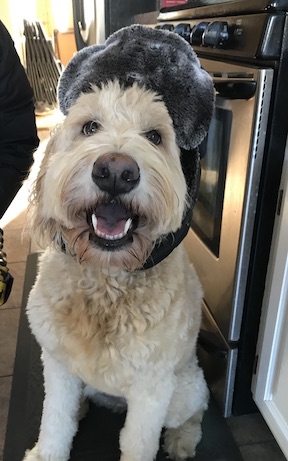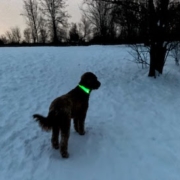10 Tips to Winterize your Pet
 We all know that we have to winterize our cars and our homes, especially those of us up here in Minne-snow-ta, but did you know that you should also winterize your pets? It is important to ensure that your pets have proper gear to safely endure the cold weather months. Here are 10 tips to help you help your pet through winter.
We all know that we have to winterize our cars and our homes, especially those of us up here in Minne-snow-ta, but did you know that you should also winterize your pets? It is important to ensure that your pets have proper gear to safely endure the cold weather months. Here are 10 tips to help you help your pet through winter.
1. Have the proper winter wear.
According to veterinarian Nancy Kay, dogs can’t layer up in the winter without our help and likely need a coat to help stay warm, especially if they have short hair and spend a good deal of time outside. Find a coat for your pet that provides warmth without limiting their mobility. It’s best to find one that covers the chest and abdomen. Smaller dogs in particular seem to have a hard time staying warm without an additional layer. But if your pup is an arctic breed, no need for a coat since their own does the job!
*I can highly recommend coats from Hurtta or Ruffwear. Here is Office Pup Piper in her Hurtta Summit Parka and Ultra Paws boots.

2. Make sure they have plenty of water.
Since your dog is both wearing extra layers and burning more calories to stay warm in the winter, they’ll need to drink extra water to stay hydrated. Good hydration is essential to your dog’s ability to regulate their body temperature. If you have water for your pet outside, be sure it is in a plastic bowl. Metal bowls can freeze and pose a risk to your pet’s tongue. Also consider a water heater or a fountain that keeps the water moving if your water bowl is outside to help prevent freezing.
3. Provide proper paw care.
Booties are ideal to help keep your pet’s paws clean and dry while romping outside in the winter. But many pups dislike wearing things on their feet. (I know we’ve all seen those videos of dogs walking in boots. While they may be funny, boots can be pretty stressful to your pup if not introduced properly!) The Dog People‘s blog has some good options for dog boots if you want to try them. If your dog doesn’t want to wear protective coverings, then keep the fur in their paws clean and trimmed short, but not too short. Hair gets wet in the snow and freezes and stays cold and wet once back indoors. You can also consider putting Musher’s Secret or another paw balm on their pads to provide some protection.
4. Avoid salt/de-icer on driveways and sidewalks.
While there are some pet friendly ice melt chemicals on the market, not all of your neighbors may think to use them. Try to avoid any areas that have been treated just in case. If your pet does walk on a treated road or sidewalk, be sure to wipe off their paws with a damp cloth when they get home. This will also help keep their pads from drying out from contact with the salt. In addition to salt on the sidewalks, prevent access to antifreeze in your home or garage. The sweet flavoring may tempt your pet but antifreeze is extremely toxic to pets.
5. Offer thicker bedding or a heated bed at home.
A slight draft in your home may not bother you, but it could put your cats or smaller dogs at risk for a chill. Put out some soft, cozy blankets or bedding that your pet can burrow into to stay warm.
6. Brush your pet consistently.
Keeping your pet knot and mat free will help them regulate their body temperature. Fur that is matted does not insulate as well and takes longer to dry. Brushing out your pet and keeping their coat clean will remove old fur and allow a fuller coat to grow in.
7. Keep an eye on their health.
Elderly pets with arthritis may have a harder time in the winter, especially in the mornings. If your pet is stiff or having difficultly with their mobility, contact your veterinarian to discuss options for treatment. In addition to their mobility, keep an eye on your pet’s weight. Some dogs and cats are less active in the winter and may need fewer calories. Some are more active or spend a good deal of time outside where they burn calories to stay warm. In that case, you may need to add a bit more to their food to keep them at the ideal weight.
8. Beware of ice, both on water and sidewalks.
We have all slipped on the ice at one point or another. Typically we recover and are not harmed, but a fall on the ice can cause injury to you or your pets. Be careful on sidewalks to avoid any icy patches. If you are out for a walk in the woods, keep your pet close to you if you reach a lake or river. If the ice is too thin your pup could fall in, creating a disastrous situation for them as well as a dangerous situation for you as you try to rescue them. The Bark website suggests keeping your pet leashed to prevent any attempts to walk out on the ice.
9. Keep your pet visible in the dark.
It gets dark pretty early in the winter so make sure that you and your pet have reflective gear so that motorists can see you on your evening walks (or so that you can see your pup in the dark on their last potty of the night). You can find reflective leashes, collars/harnesses, and safety jackets for your pet at multiple retailers to keep them in sight. Check out Chewy.com’s available items here.
10. Learn about your breed’s needs.
Some dogs need more or more specific care in the winter. While some breeds like Malamutes, Newfoundlands, or Samoyeds have a thick double coat designed to keep them warm, other dogs may need a coat, limited exposure to the elements, or extra care to ensure they stay safe and healthy. BarkPost suggests you can check with the American Kennel Club or ASPCA for more breed specific information. A good rule of thumb for all pets though, is if it is too cold for you it is too cold for them! Bring your pets inside when it becomes too cold.
Bonus tip: If you park your car outside in the winter, be sure to tap on the hood and make some noise before starting your car. Warm engine blocks are tempting to cats and small wildlife, who may curl up inside where you cannot see them. You may want to bang on your hood to shoo them away before you turn over the engine.
Or you could just move to Arizona and never have to deal with a winter again! It’s up to you, but my pups love the snow too much to ever leave. So if your pup is like mine, be sure to keep them safe while they romp (or snooze) through the winter.
